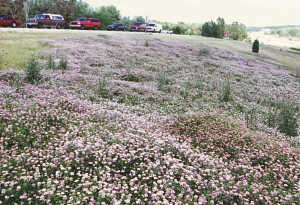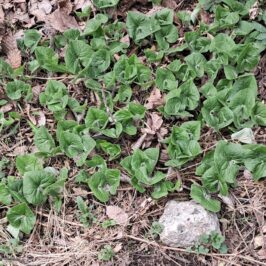I hope in this post to raise awareness of a few of the more troublesome weeds we deal with at Warwick Way Gardens. These are some of the ones that are especially problematic for those of us trying to grow native plants to benefit pollinators, including butterflies, bumblebees, and the many other insects that contribute to our complex, biodiverse, and beautiful ecosystem. Non-native plants like Creeping Bellflower, Queen Anne’s Lace, Crown Vetch, Bird’s Foot Trefoil and Burdock can easily take over an area and out-compete the beneficial natives. Some non-natives may have pretty blooms, and tempt us to let them be, but they have not co-evolved alongside our native insects and do not provide the best nutrition. It will go a long way towards helping our insect pollinators and our native plant gardens if we all learn to recognize some of these plants and try to control them in our own yards, and if possible, in the street terraces.
Let’s start with Creeping Bellflower, Campanula rapunculoides, which is seen almost everywhere in people’s yards, gardens, anywhere that’s not mowed or weeded regularly. A native to Europe, it is considered invasive in the Midwest and is on the Wisconsin DNR’s list of Restricted Invasives. It can quickly take over an area by prolific seed production and by a system of fairly deep (6 -8 inches) and sturdy underground roots.
It is a biennial, meaning in its first year, the plants don’t produce flowers, and look almost like an innocent little violet. The second year, it will put up a 2 -3 ft flowering stalk, covered with pretty blue bell-shaped flowers. The only effective way to get rid of it is to dig several inches deep to get out all the roots. That’s a real problem if it’s in the middle of your bed of desired, valued native plants. Individual flowering stalks can be easily pulled, which reduces spreading by seed, but the plant will keep sending up more stalks from those roots and from smaller shallower roots also. My bottom line advice/plea is, please, dig it out where you can, or at least pull the flowering stalks and bag any seed heads to limit spreading by seed!
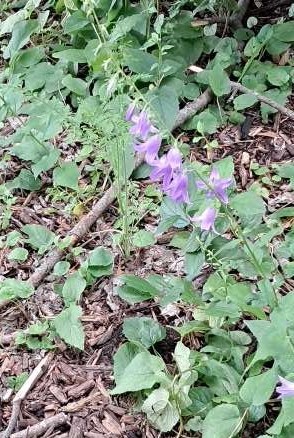
Queen Anne’s Lace (Daucus Carota) is another non-native that is seen all along road sides, fields, and in the street terraces. It is essentially a wild carrot, with a strong tap root, finely divided foliage, and a flat cluster of tiny white flowers. The flower head, sitting on a 2 – 3 ft stalk, can produce thousands of seeds that easily take over any disturbed soil. They have seeded into the Pollinator Garden.
If you have it in your yard or street terrace, mowing it consistently will at least minimize seed production which could otherwise spread into other areas. In the gardens we are digging up or pulling the entire taproot and disposing of seed heads. You may protest that this plant is a host for Black Swallowtail caterpillars. That is actually true, however there are other native plants, like Golden Alexanders, that serve a similar function. There are also less invasive herbs like dill, parsley and fennel that are host plants for those caterpillars.

Next on my list is Crown Vetch (Coronilla varia), another one on DNR’s Restricted list. It spreads by underground rhizomes that can grow up to 10 ft in a year. The above-ground stems can be numerous and very long. One single plant can cover up to 100 square feet in four years.
Crown Vetch has historically been planted along roadsides in attempts to control erosion. It grows well in a wide range of moisture conditions and in poor soil. At Warwick Way Gardens it grows thickly along the sound wall and in the grass to the west of the gardens. We are now fighting it in the rain garden. We will do our best to dig it out, roots and all, before the flowers have a chance to produce seed.
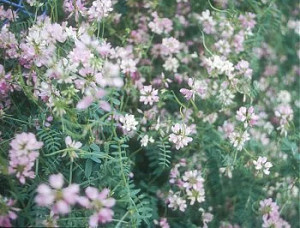
Bird’s Foot Trefoil, Lotus corniculatus, is another plant that some folks find “pretty”, with a bright yellow pea-like flower. Being a legume, it can fix nitrogen from the air, and does well in very poor soil, growing along sidewalks and curbs. It sends out many long stems from a tough root, and spreads via seeds, rhizomes, and stems. The grassy areas in our gardens have lots of it, and it moves into the Pollinator and Rain Gardens from the edges. One photo shows me holding up a single plant dug out of the Rain Garden, with stems hanging down 5 feet! We are digging it out of the garden borders, and cutting and bagging flowers to prevent it from producing seeds.
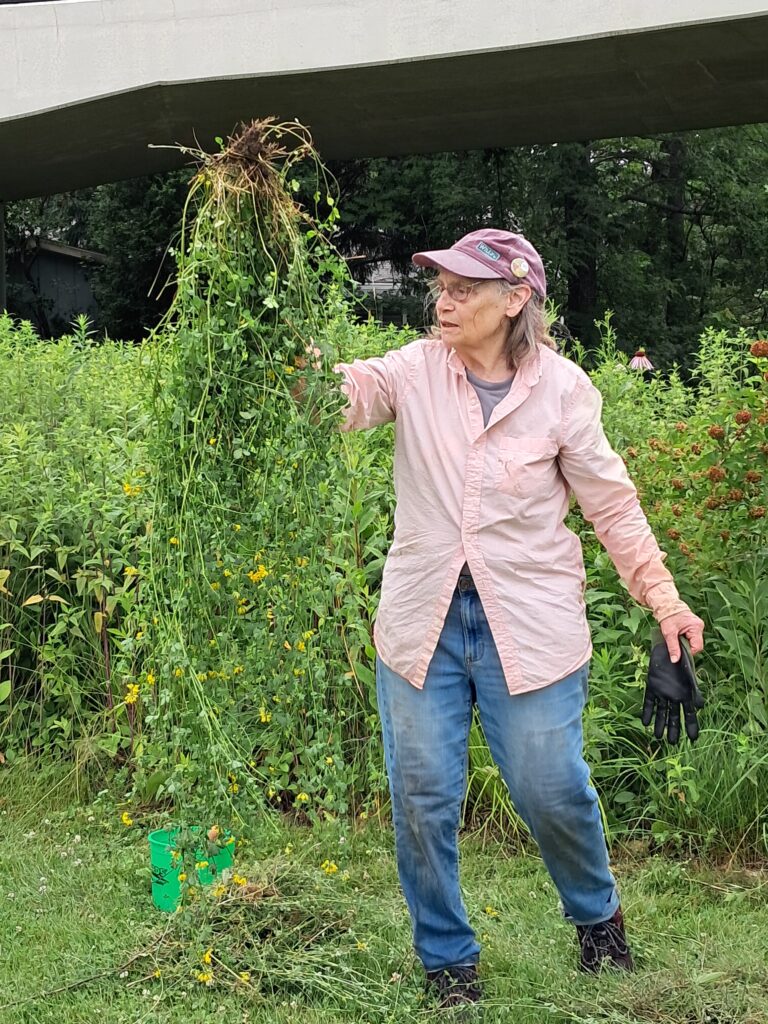
I will stop at one more “baddy”, Common Burdock, Arctium minus. In its first year it produces a thick tough root and a rosette of very large leaves that look almost like rhubarb. It is not rhubarb! The next year it puts up a 2 to 5 foot stalk with small violet flowers surrounded by bracts that develop into spiky hooked burs about ½ inch wide. They are considered a hazard, as they will catch into hair, clothing, animal fur and feet, and even trap bats and small birds into a tangle they can’t escape. We dug out several of these in the early days. The spread can be prevented by cutting off the stalks with burs and collecting and disposing them in the trash. Please, if these are growing in your street terrace, cut and bag the stalks with burs. Your neighbors’ dogs and I will thank you!

Before I leave you thoroughly discouraged, I will assure you that, with volunteer help, the Pollinator and Rain Gardens are resisting a complete weedy takeover! The rain this year has been extremely beneficial, and many plants are getting taller than ever. As the season progresses, more plants that we put in last year keep showing up, and are blooming. I promise my next post will feature the lush plant growth and the great variety of colorful flowers! As always, be sure to email area6@cmnna.org with questions or to offer to help!



